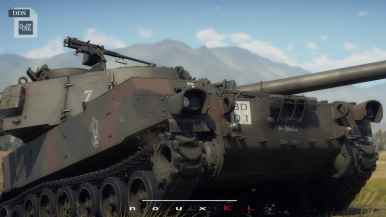



The M109A1 was introduced into American service in 1973 as an improved version of the M109 self-propelled howitzer. The main improvement was the installation of a new 155 mm M185 cannon, which had a longer barrel and a higher muzzle velocity than the previous M126. This increased the effective range of the M109A1 from 14.6 km to 18 km, giving it an advantage over foreign artillery. It was known for its role in supporting the US Army's operations in Europe and the Middle East, where it could provide fire support for ground forces and counter-battery fire against enemy artillery. The existing M109A1's were later converted to the M109A2 standard, which incorporated 27 RAM (Reliability, Availability, Maintainability) improvements.
The M109A1 was introduced in Update "Kings of Battle". It has similar characteristics to the Soviet 2S3M and can deliver powerful 155 mm shells over long distances and relocate swiftly to evade enemy fire. The M109A1 has a terrible rate of fire and large ammo capacity, and its mobility is complemented by a good top speed and acceleration. However, its armour is not very thick, so it's recommended to use the M109A1's speed to avoid direct confrontations when possible. Moreover, it is essential to keep in mind that the M109A1 has low gun depression and cannot depend on firing from elevated positions.
| Ammunition | Type | Armor penetration (mm) at a distance: | |||||
|---|---|---|---|---|---|---|---|
| 10 m | 100 m | 500 m | 1000 m | 1500 m | 2000 m | ||
| HE | 61 | 61 | 61 | 61 | 61 | 61 | |
| Smoke | 5 | 5 | 5 | 5 | 5 | 5 | |
| HE-VT | 61 | 61 | 61 | 61 | 61 | 61 | |
| Belt | Belt filling | Armor penetration (mm) at a distance: | |||||
|---|---|---|---|---|---|---|---|
| 10 m | 100 m | 500 m | 1000 m | 1500 m | 2000 m | ||
| API-T/I/AP/API-T | 31 | 29 | 21 | 14 | 9 | 6 | |












Mobility | |
|---|---|
Protection |
|---|
Firepower | |
|---|---|
